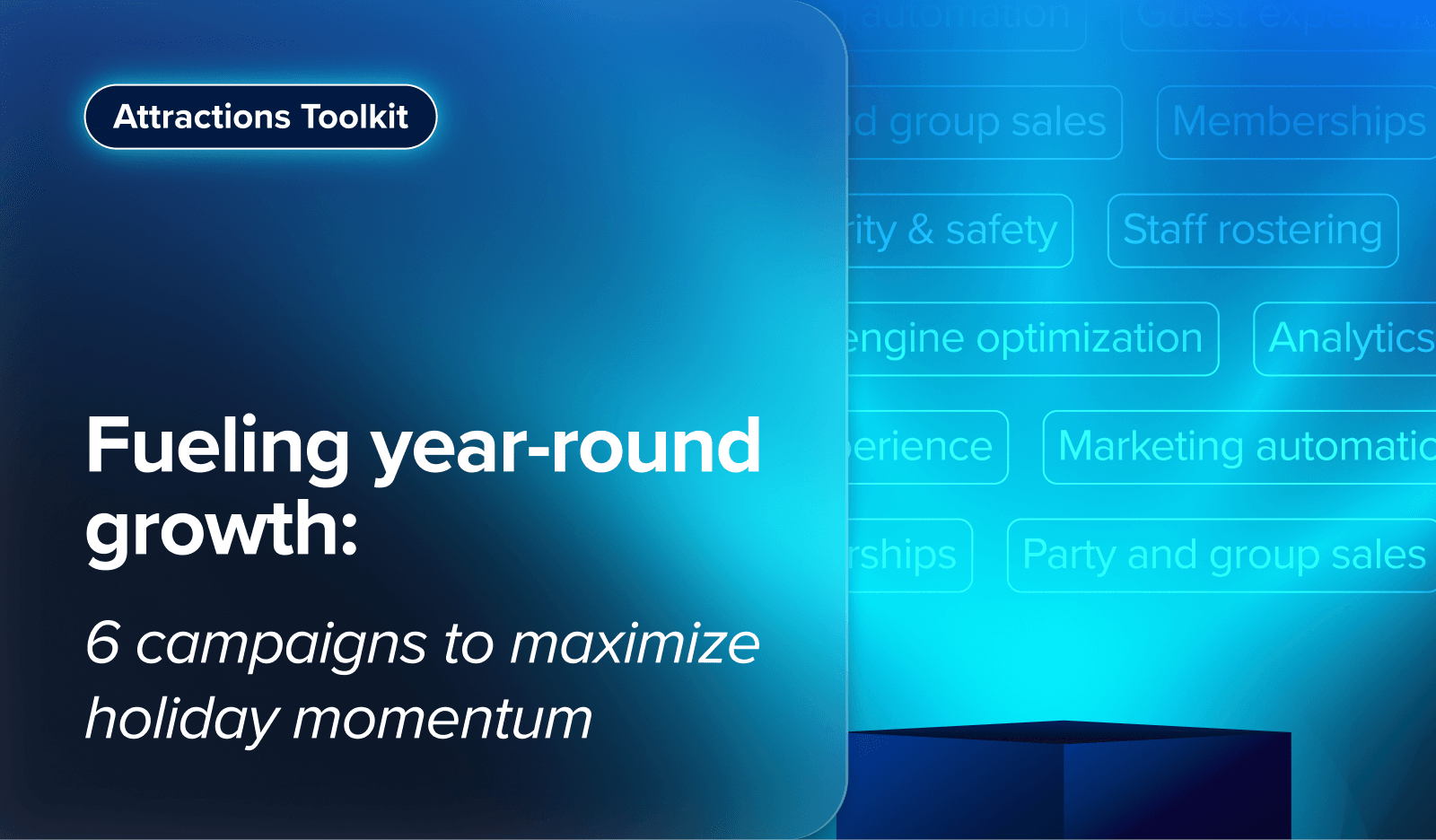Customer Segmentation Strategies: How Attractions Can Personalize Experiences and Drive Revenue

Understanding your guests is the key to creating unforgettable experiences. In the competitive world of attractions and family entertainment, knowing who your customers are, what they value, and how they behave is critical. That’s where customer segmentation comes in.
Customer segmentation is a powerful marketing and operations strategy that helps you divide your guest base into distinct groups (or customer segments) based on shared characteristics. By doing so, you can tailor your services, messaging, pricing, and promotions to better meet the needs of each group. In this guide, we’ll walk through the fundamentals of customer segmentation, explore common models, and show how you can turn your customer data into action.
What is customer segmentation?
Customer segmentation is the practice of dividing your broader customer base into smaller groups based on similarities in demographics, behavior, preferences, or needs. This allows businesses to better understand their audience and deliver more relevant, personalized experiences.
In attractions and family entertainment centers (FECs), this might mean segmenting guests by age, visit frequency, spending habits, or activity preferences. The goal is to understand who your most valuable guests are and how you can attract more like them.
Why customer segmentation matters for attractions
Customer segmentation for attractions helps operators move from a one-size-fits-all approach to a more personalized, guest-centric strategy. Here are some key benefits:
- Improved guest satisfaction: By tailoring offers and experiences to specific segments, you can delight your guests and build loyalty.
- Smarter marketing: Segmentation allows you to target different guest types with relevant promotions and messaging.
- Better resource allocation: Focus your marketing spend and operational efforts where they’ll have the greatest impact.
- Increased revenue: Personalized offers and targeted upsells can lead to higher per-guest spend.
Read more: Unlocking the Power of Analytics: How to Leverage Data for Marketing
Common customer segmentation models
There are several ways to segment your customers, depending on the type of data you have and your business goals. Below are some of the most common and effective customer segmentation models:
Demographic segmentation
Demographic segmentation involves dividing your guests based on measurable characteristics such as age, gender, income, education level, and family status. This model is commonly used because this data is often readily available and easy to analyze. For example, you might promote toddler-friendly activities to young parents or market high-end packages to high-income earners. Demographic insights help you shape offerings, pricing, and messaging for each audience type.
Geographic segmentation
Geographic segmentation groups customers based on their physical location—such as country, region, city, or even proximity to your venue. Attractions can tailor marketing campaigns to reflect local climate, culture, holidays, or school schedules. For example, indoor attractions might be marketed more heavily during cold months in northern regions, while summer promotions could target families in warm-weather areas.
Behavioral segmentation
Behavioral segmentation focuses on how customers interact with your brand. This includes their purchasing habits, visit frequency, preferred activities, booking method, or engagement with your marketing content. A guest who regularly visits for trampoline sessions might receive fitness class promotions, while someone who browsed birthday party pages but didn’t book could receive a follow-up email. Behavioral segmentation enables personalized outreach based on real actions.
Psychographic segmentation
Psychographic segmentation delves into your guests’ interests, values, beliefs, and lifestyles. It’s about understanding why your guests behave the way they do. For instance, one segment may prioritize fun and adrenaline, while another may value safety and learning experiences. Attractions that cater to different values—such as thrill-seekers vs. wellness enthusiasts—can design more targeted offerings and messaging.
Needs-based segmentation
Needs-based segmentation divides your audience based on their specific emotional, functional, or logistical needs. A parent planning a birthday party has different goals than a school teacher organizing a field trip. Identifying these needs allows attractions to tailor product bundles, messaging, and scheduling to meet the unique demands of each audience segment.
Value-based segmentation
Value-based segmentation groups customers based on their overall financial contribution to your business. This might include total spend, frequency of visits, or lifetime value. By identifying high-value customers, you can prioritize them for loyalty programs, exclusive offers, or premium experiences. It also helps allocate marketing spend to the most profitable audience segments, improving return on investment.
Technographic segmentation
Technographic segmentation considers the technology your customers use—such as mobile apps, operating systems, or booking platforms. If your data shows that a large portion of guests book through mobile, you might offer mobile-only discounts or streamline your mobile UX. This model is particularly useful for attractions that rely on digital touchpoints like self-service kiosks, QR code menus, or loyalty apps.
These customer segmentation models can be used individually or in combination to create more refined guest profiles that guide marketing and operational decisions. Choosing the right models often depends on your business goals, available data, and the types of experiences you aim to deliver.
How to segment customers effectively
If you’re wondering how to segment customers at your venue, here’s a simple step-by-step approach:
- Gather customer data: Use your point-of-sale system, CRM, online ticketing platform, guest feedback tools, and social media analytics to collect as much data as possible about your guests.
- Identify key segmentation variables: Look for common traits or behaviors that matter to your business—such as family size, visit frequency, or interest in birthday party packages.
- Group customers into segments: Use segmentation analysis tools or CRM-based segmentation features to divide your audience into meaningful customer segments.
- Create segment-specific strategies: Tailor marketing campaigns, email communications, pricing models, and in-venue experiences to appeal to each group.
- Test and optimize: Track performance and refine your customer segmentation strategies over time based on what works.
How to personalize experiences with data
Once you’ve segmented your guests, the next step is to act on that insight. Here are some ways to personalize the guest experience using data:
- Customized emails: Send tailored messages based on past visits or expressed interests.
- Dynamic pricing: Offer discounts during off-peak hours to segments with flexible schedules.
- Targeted promotions: Promote group packages to family segments and VIP upgrades to high spenders.
- In-venue experiences: Personalize greetings, recommend activities, or surprise repeat visitors with rewards.
Read more: 5 Ways Smart Data Collection Can Save Attraction Venues Time and Money
Tools that support customer segmentation
To implement effective customer segmentation in marketing and operations, attractions can use a variety of tools, including:
- CRM systems: Manage and organize customer data and automate communication workflows.
- POS and ticketing systems: Track purchasing behavior and visit frequency.
- Marketing automation tools: Create targeted email campaigns and promotions.
- Analytics dashboards: Monitor guest behavior trends and campaign effectiveness.
Best practices for customer segmentation
To get the most value out of your segmentation strategy, follow these best practices:
- Start simple: Don’t feel pressured to create dozens of segments right away. Begin with three to five clearly defined groups that align with your most important business goals. You can always expand your approach as you gather more data.
- Use reliable data: Ensure the data you’re working with is accurate, current, and complete. Outdated or incorrect data can lead to misguided decisions and irrelevant messaging.
- Stay flexible: Guest behavior can change over time due to seasonality, market trends, or new offerings. Revisit your segments regularly to ensure they still reflect your actual audience and their preferences.
- Keep it actionable: Avoid creating segments that are interesting but hard to serve. Instead, focus on groups that you can directly engage with tailored offers, content, or operational changes.
- Protect guest privacy: Be transparent about data collection and comply with relevant data protection regulations.
Customer segmentation examples for attractions
To bring these concepts to life, here are some practical customer segmentation examples commonly used in the attractions and FEC industry. These real-world applications show how different types of segmentation can directly impact marketing and guest engagement:
Frequent family visitors
This segment includes families who visit your venue more than twice per month. These guests are likely your most loyal supporters, and it’s important to keep them engaged. Consider offering them exclusive loyalty rewards, family memberships with added value, or early access to new attractions and special events.
Birthday party planners
Parents who are actively searching for children’s party venues are a valuable audience segment. You can target this group with seasonal party promotions, downloadable planning checklists, or limited-time discounts on birthday packages. Timely messaging and helpful content can increase conversion rates during the decision-making process.
High spenders
Guests who consistently spend more per visit—whether through ticket upgrades, food and beverage, or merchandise—represent a high-value segment. For these customers, consider upselling VIP experiences, offering bundled packages with extra perks, or sending personalized thank-you offers to build long-term loyalty.
First-time visitors
New guests often need a bit more guidance and encouragement to return. Welcome them with a follow-up email that includes a bounce-back offer, highlights your most popular attractions, or provides insider tips for their next visit. Personal touches can turn a one-time visitor into a repeat guest.
Local guests vs. tourists
Locals may be more interested in season passes, multi-visit memberships, or weekday promotions. On the other hand, tourists might be seeking all-inclusive day passes or convenient bundle deals. Understanding where your guests are coming from allows you to adjust your offerings and messaging to better suit their needs and expectations.
Conclusion
Customer segmentation is a strategic approach that allows attractions to deliver more relevant, personalized experiences at every stage of the guest journey. By identifying and understanding your most valuable customer segments, you can move beyond generic messaging and start connecting with guests in ways that truly resonate.
Whether you're trying to boost repeat visits, sell more party packages, or improve operational efficiency, the right customer segmentation strategy will help you create targeted campaigns that speak directly to your guests’ needs and preferences.
Book a demo to see how ROLLER can help you boost revenue, streamline operations, and delight guests.
Frequently asked questions about customer segmentation
What is customer segmentation?
What is customer segmentation in marketing?
What are examples of customer segments?
How does customer segmentation increase revenue?
What tools help with customer segmentation?
How can attractions use customer segmentation?
What are best practices for customer segmentation?
Related articles


Attractions Toolkit: 6 Marketing Automation Campaigns to Maximize Holiday Momentum

What Every Venue Needs to Know About Birthday Parties (from a Parent and a Pro)
Enhance your guest experience
Get free education, tips and inspiration to help you run a successful venue.
